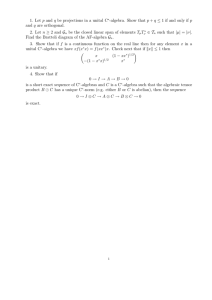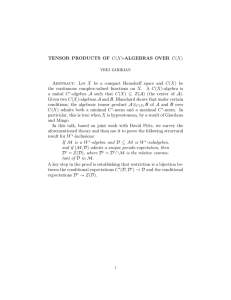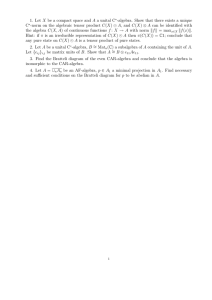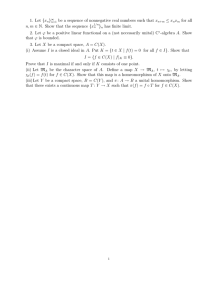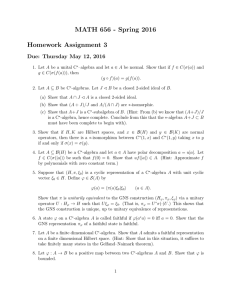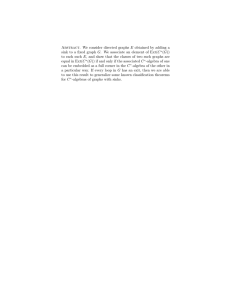Suspending Lefschetz fibrations, with an application to Local Mirror Symmetry Please share
advertisement
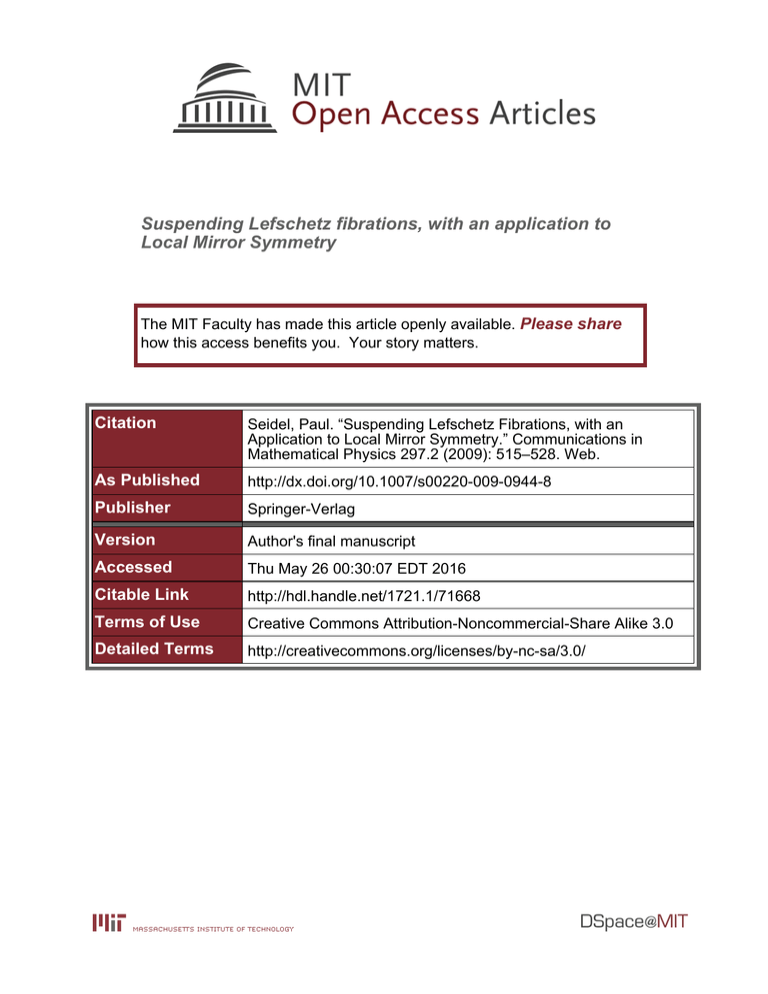
Suspending Lefschetz fibrations, with an application to
Local Mirror Symmetry
The MIT Faculty has made this article openly available. Please share
how this access benefits you. Your story matters.
Citation
Seidel, Paul. “Suspending Lefschetz Fibrations, with an
Application to Local Mirror Symmetry.” Communications in
Mathematical Physics 297.2 (2009): 515–528. Web.
As Published
http://dx.doi.org/10.1007/s00220-009-0944-8
Publisher
Springer-Verlag
Version
Author's final manuscript
Accessed
Thu May 26 00:30:07 EDT 2016
Citable Link
http://hdl.handle.net/1721.1/71668
Terms of Use
Creative Commons Attribution-Noncommercial-Share Alike 3.0
Detailed Terms
http://creativecommons.org/licenses/by-nc-sa/3.0/
arXiv:0907.2063v2 [math.SG] 5 Aug 2009
SUSPENDING LEFSCHETZ FIBRATIONS,
WITH AN APPLICATION TO LOCAL MIRROR SYMMETRY
PAUL SEIDEL
1. Introduction
Let Y be a smooth toric del Pezzo surface, and KY the total space of its canonical
bundle. Let Db (Coh(KY )) be the bounded derived category of coherent sheaves
on KY , and DYb (Coh(KY )) the full subcategory consisting of complexes whose cohomology is supported on the zero-section Y ⊂ KY . The mirror to KY (see [10,
Section 8] or [8]) is the hypersurface
(1.1)
H = {(x, y) ∈ (C∗ )2 × C2 : y1 y2 + p(x) = z},
Here, p : (C∗ )2 → C is the superpotential mirror to Y (following [7] or [9]), and z is
any regular value of p. H is an affine threefold with trivial canonical bundle. Hence,
it has a Fukaya category Fuk(H), whose objects are compact exact Lagrangian
submanifolds equipped with gradings and Spin structures. This is an A∞ -category
over C. Consider the associated derived category D(Fuk(H)).
Theorem 1.1. There is a full embedding of triangulated categories,
(1.2)
DYb (Coh(KY )) ֒→ D(Fuk(H)).
To explain the strategy of the proof, we need to return to Y itself. Homological
mirror symmetry for such varieties, first considered by Kontsevich [11], is now
a theorem (see [15] for Y = CP 2 , [2] for several more cases, and [1, 19] for all
remaining ones). On the other hand, Segal [14] and Ballard [3] independently
proved a result which describes, on the level of the underlying A∞ -algebras, the
relation between Db (Coh(Y )) and DYb (Coh(KY )). The missing piece, which we
provide here, is a corresponding statement about the relation between the Fukaya
category of the Lefschetz fibration p and that of the hypersurface H. We can prove
this relation only partially, which is why we get an embedding (1.2) instead of the
ultimately desirable equivalence.
The proof of Theorem 1.1 is in fact an application of a more general result about
suspending Lefschetz fibrations (Theorem 6.4), which means passing from p(x) to
2
for any number of variables. Independently of the present
p(x) − y12 − · · · − ym
work, Futaki and Ueda [6] have applied similar methods to p(x) − y k for k ≥ 2.
However, their interest is directed towards mirror symmetry for Landau-Ginzburg
models, hence their computations concern only directed Fukaya categories.
Date: July 12, 2009.
1
2
PAUL SEIDEL
Acknowledgments. This problem was brought to my attention by Matthew Ballard.
I would like to thank him, Mohammed Abouzaid, Mark Gross, and Ivan Smith for
useful conversations. NSF grant DMS-0652620 provided partial support.
2. Algebraic suspension
Fix a ground field K, which will be used throughout. We will describe a suspension
construction, which starts from a pair (A, B) consisting of an A∞ -algebra B and
an A∞ -subalgebra A ⊂ B, and produces another pair (Aσ , B σ ) of the same kind.
In fact Aσ is isomorphic to A in a straightforward way, but B σ is usually not even
quasi-isomorphic to B. We will see that in general, the construction leads to a loss
of information, which means that it cannot be reversed in a meaningful (that is,
quasi-isomorphism invariant) way.
Here is the most elementary description. As a graded vector space
B σ = A+ ⊕ A− ⊕ B[−1],
(2.1)
where both A+ and A− are copies of A. The shift [−1] means that elements of
B σ of degree r are triples (a+ , a− , b), where a± ∈ A have degree r, and b ∈ B has
degree r − 1. The differential is
(2.2)
µ1Bσ (a+ , a− , b) = (µ1A (a+ ), µ1A (a− ), −µ1B (b) − a+ + a− ).
The higher order A∞ -structure maps, for d ≥ 2, are
(2.3) µdBσ ((ad,+ , ad,− , bd ), . . . , (a1,+ , a1,− , b1 ))
= µdA (ad,+ , . . . , a1,+ ), µdA (ad,− , . . . , a1,− ),
d
X
i=1
(−1)ka1,− k+···+kai−1,− k+1 µdB (ad,+ , . . . , ai+1,+ , bi , ai−1,− , . . . , a1,− ) .
The notational convention is that kak = deg(a) − 1 is the reduced degree. The
subspace Aσ ⊂ B σ just consists of triples of the form (a, a, 0).
Example 2.1. It maybe makes sense to write down the construction in the simpler special case of dga’s, taking into account the differences in sign conventions.
Namely, if A ⊂ B are dga’s, the dga structure on the suspension B σ is given by
(2.4)
d(a+ , a− , b) = (da+ , da− , db − (−1)deg(a+ ) a+ + (−1)deg(a− ) a− ),
(a2,+ , a2,− , b2 ) · (a1,+ , a1,− , b1 ) =
= (a2,+ a1,+ , a2,− a1,− , a2,+ b1 + (−1)deg(a1,− ) b2 a1,− ).
The fact that (2.2), (2.3) satisfy the A∞ -associativity equations can be checked
by hand, but there is also an equivalent description which makes these equations
obvious. Start with the following contractible complex of vector spaces:
(2.5)
1
C = {· · · 0 → K −
→ K → 0 · · · },
where the nontrivial generators are in degrees −1 and 0. Let hom K (C, C) be the
differential graded algebra of endomorphisms of C. Consider the tensor product
LEFSCHETZ FIBRATIONS
3
B ⊗ hom K (C, C), which is again an A∞ -algebra. As a graded vector space,
(2.6)
B ⊗ hom K (C, C) = B[1] ⊕ B+ ⊕ B− ⊕ B[−1],
where B+ is B tensored with the endomorphisms of the degree 0 part of C, and
B− similarly for the degree −1 part of C. Define B σ as an A∞ -subalgebra of
B ⊗ hom K (C, C) in the obvious way. This leads to the formulae described above.
For instance, the additional terms in the differential (2.2) are precisely the ones
inherited from the differential on hom K (C, C).
Remark 2.2. One can recast the previous description in slightly different language
as follows. Assume that B is strictly unital, with identity element e. Consider it as
an A∞ -category with a single object V , and let Tw (B) be the associated A∞ -category
of twisted complexes. This contains a contractible object, which is the mapping cone
S = Cone(e : V → V ). Then
(2.7)
hom Tw(B) (S, S) = B ⊗ hom K (C, C)
as an A∞ -algebra, and one can again define B σ as an A∞ -subalgebra of this (our
sign conventions differ from those of [17, Section 3k], essentially because we think of
twisted complexes as formal tensor products with graded vector spaces on the right
side, rather than the left one).
There is a special class of examples where the effect of suspension is quite simple.
To explain this, we need the notion of an A∞ -bimodule over A, which is a graded
vector space P together with operations
s|1|r
(2.8)
µP
: A⊗s ⊗ P ⊗ A⊗r −→ P[1 − r − s]
for all r, s ≥ 0, satisfying appropriate equations. A straightforward example is the
diagonal bimodule, which is A itself with
(2.9)
d−i|1|i−1
µA
(ad , . . . , a1 ) = (−1)ka1 k+···+kai−1 k+1 µdA (ad , . . . , a1 ).
We will also need the shift operation, which takes P to the shifted vector space
P[−1] with operations
s|1|r
(2.10) µP[−1] (ar+s , . . . , ar+1 , p, ar , . . . , a1 )
s|1|r
= (−1)ka1 k+···+kar k+1 µP
(ar+s , . . . , ar+1 , p, ar , . . . , a1 ).
s|1|r
. For a more
Hence, the shifted diagonal bimodule A[−1] has µA[−1] = µs+1+r
A
thorough exposition of the theory of A∞ -bimodules and their morphisms, see [18,
16] (our sign conventions are related to those in [16] by reversing the ordering of
the entries in (2.8), which brings things in line with [17]).
For any given A∞ -algebra A and A-bimodule P, one can define the trivial extension
A∞ -algebra A ⊕ P, which is the direct sum of vector spaces equipped with the
structure maps
(2.11) µdA⊕P ((ad , pd ), . . . , (a1 , p1 )) = µdA (ad , . . . , a1 ),
d
X
i=1
d−i|1|i−1
(−1)ka1 k+···+kai−1 k+1 µP
(ad , . . . , ai+1 , pi , ai−1 , . . . , a1 ) .
4
PAUL SEIDEL
This obviously contains A as an A∞ -subalgebra. The suspension of B = A ⊕ P is
B σ = A+ ⊕ A− ⊕ A[−1] ⊕ P[−1], with
0|1|0
µ1Bσ (a+ , a− , a, p) = (µ1A (a+ ), µ1A (a− ), −µ1A (a) − a+ + a− , µP
(2.12)
(p))
and, for d ≥ 2,
(2.13) µdBσ ((ad,+ , ad,− , ad , pd ), . . . , (a1,+ , a1,− , a1 , p1 ))
= µdA (ad,+ , . . . , a1,+ ), µdA (ad,− , . . . , a1,− ),
d
X
(−1)ka1,− k+···+kai−1,− k+1 µdA (ad,+ , . . . , ai+1,+ , ai , ai−1,− , . . . , a1,− ),
i=1
d
X
d−i|1|i−1
µP
i=1
(ad,+ , . . . , ai+1,+ , pi , ai−1,− , . . . , a1,− ) .
This contains the A∞ -subalgebra of elements of the form (a, a, 0, p), which is isomorphic to the trivial extension A ⊕ P[−1]. Moreover, the induced differential on
the quotient B σ /(A ⊕ P[−1]) ∼
= A ⊕ A[−1] is acyclic. We have therefore shown:
Lemma 2.3. If B is a trivial extension A ⊕ P, then its suspension B σ is quasiisomorphic to the trivial extension A ⊕ P[−1].
3. A topological viewpoint
This section is a digression from our main argument, and its only purpose is to
build some topological intuition. Let U be a topological manifold with boundary
W = ∂U (in fact, more general topological spaces and subspaces are also possible).
Let A = C ∗ (U ) be the dga of singular cochains with coefficients in K. Set B =
C ∗ (U ) ⊕ C ∗ (U, W )[1], with the differential and multiplication given, in terms of the
standard differential δ and cup-product on cochains, by
(3.1)
d(b, c) = (δb + (−1)deg(c) c, δc),
(b2 , c2 ) · (b1 , c1 ) = (b1 b2 , b2 c1 + (−1)deg(b1 ) c2 b1 ).
By definition, the map B → C ∗ (W ), (b, c) 7→ b|W , is a quasi-isomorphism of dga’s.
The point of replacing C ∗ (W ) by its quasi-isomorphic version B is that it allows us
to view the restriction map C ∗ (U ) → C ∗ (W ) as the inclusion A ֒→ B.
Consider the suspension of B, which following Example 2.1 is the dga B σ = C ∗ (U )⊕
C ∗ (U ) ⊕ C ∗ (U )[−1] ⊕ C ∗ (U, W ) with
d(a+ , a− , b, c) = (δa+ , δa− ,
(3.2)
δb − (−1)deg(a+ ) a+ + (−1)deg(a− ) a− + (−1)deg(c) c, δc),
(a2,+ , a2,− , b2 , c2 ) · (a1,+ , a1,− , b1 , c1 ) =
= (a2,+ a1,+ , a2,− a1,− , a2,+ b1 + (−1)deg(a1,− ) b2 a1,− , a2,+ c1 + c2 a2,− ).
LEFSCHETZ FIBRATIONS
5
Let W σ = U+ ∪W U− be the manifold obtained by gluing two copies of U along
their common boundary. This comes with a dga homomorphism
C ∗ (W σ ) −→ B σ ,
(3.3)
a 7−→ (a|U+ , a|U− , 0, a|U+ − a|U− ).
This implicitly uses the fact that the restrictions a|U± agree along their boundaries,
so that their difference is naturally a relative cochain. As a map of chain complexes,
(3.3) sits in a commutative diagram with short exact rows,
(3.4)
/ C ∗ (U− )
/0
/ C ∗ (W σ )
/ C ∗ (W σ , U− )
0
0
/ C ∗ (U, W )
/ C ∗ (U ) ⊕ C ∗ (U ) ⊕ C ∗ (U )[−1]
/ Bσ
/ 0.
The lower row consists of the maps c 7→ (c, 0, 0, c) and (a+ , a− , b, c) 7→ (a+ −c, a− , b).
The left hand vertical arrow is restriction from W σ to U+ = U , and the right hand
one is a 7→ (a, a, 0) with respect to the identification U− = U . The two lastmentioned maps are quasi-isomorphisms, hence so is (3.3).
Next, W σ is naturally the boundary of a manifold U σ which is homotopy equivalent
to U , namely
(3.5)
U σ = U × [−1, 1] / (x, t) ∼ (x, s) for x ∈ W .
The maps induced by projection U σ → U and inclusion W σ ֒→ U fit into a commutative diagram of dga’s,
(3.6)
C ∗ (U )
≃
/ C ∗ (U σ )
/ C ∗ (W σ )
≃
≃
Aσ
/ Bσ .
Hence, in this context suspension is the algebraic counterpart of the topological
process of passing from (U, W ) to (U σ , W σ ).
4. General properties
We return to general pairs (A, B). The inclusion A ⊂ B makes B into an A∞ bimodule over A, in the same way as in (2.9). It contains the diagonal bimodule
A, so the quotient B/A is naturally an A∞ -bimodule as well, and we have a short
exact sequence
(4.1)
ι
π
0→A−
→B−
→ B/A → 0.
Lemma 4.1. Suppose that we have two pairs (A, B) and (A, B̃), together with an
A-bimodule quasi-isomorphism φ : B̃ → B which restricts to the identity on A.
Then there is an induced quasi-isomorphism of A∞ -algebras φσ : B̃ σ → B σ .
Proof. Our given φ has components φs|1|r : A⊗s ⊗ B̃ ⊗ A⊗r → B[−r − s]. Define
(4.2)
φσ,1 (a+ , a− , b) = (a+ , a− , φ0|1|0 (b)),
6
PAUL SEIDEL
which is obviously a quasi-isomorphism, and for d ≥ 2,
(4.3) φσ,d ((ad,+ , ad,− , bd ), . . . , (a1,+ , a1,− , b1 ))
= 0, 0,
d
X
φd−i|1|i−1 (ad,+ , . . . , ai+1,+ , bi , ai−1,− , . . . , a1,− ) .
i=1
It is straightforward to check the A∞ -homomorphism equations.
Lemma 4.2. Suppose that there is an A∞ -bimodule map ξ : B/A → B whose
composition with the projection π : B → B/A is a quasi-isomorphism from B/A
to itself. Then B σ is quasi-isomorphic to the trivial extension A∞ -algebra A ⊕
(B/A)[−1].
Proof. Consider the A-bimodule B̃ = A ⊕ (B/A). The inclusion ι and the map ξ
combine to yield an A-bimodule map ι ⊕ ξ : B̃ → B. Just seen as a map of chain
complexes, this sits in a commutative diagram
(4.4)
0
/A
0
/A
id
/ B̃
ι⊕ξ
/B
/ B/A
/0
(π◦ξ)0|1|0
/ B/A
/ 0,
hence is itself a quasi-isomorphism. Now consider B̃ as an A∞ -algebra, namely
the trivial extension of A by B/A. By Lemma 4.1, our bimodule map induces a
quasi-isomorphism between the suspensions B̃ σ and B σ . But Lemma 2.3 says that
the first of these is quasi-isomorphic to A ⊕ (B/A)[−1], which implies the desired
result.
Lemma 4.3. Take any (A, B). Then there is a map ξ σ : B σ /Aσ → B σ of bimodules
over Aσ = A whose composition with the projection B σ → B σ /Aσ is a quasiisomorphism from B σ /Aσ to itself.
Proof. Consider the subspace of B σ consisting of elements of the form (a+ , 0, b).
This is a sub-bimodule over Aσ . Projection from that bimodule to B σ /Aσ is an
isomorphism, hence admits a unique strict inverse.
The principal consequence of the discussion above is the following:
Proposition 4.4. For any (A, B), the double suspension B σσ is an A∞ -algebra
quasi-isomorphic to the trivial extension A ⊕ (B/A)[−2].
Proof. Apply Lemma 4.3 to (A, B), and then Lemma 4.2 to (Aσ , B σ ). The consequence is that B σσ is quasi-isomorphic to the trivial extension of Aσ ∼
= A by the
bimodule (B σ /Aσ )[−1]. Projection B σ /Aσ = A ⊕ B[−1] → (B/A)[−1] is a quasiisomorphism of A-bimodules, and induces a quasi-isomorphism of the associated
trivial extension A∞ -algebras.
LEFSCHETZ FIBRATIONS
7
5. Fukaya categories
Let (M, ω) be a 2n-dimensional symplectic manifold, and (V1 , . . . , Vm ) an ordered
collection of Lagrangian spheres in M . To apply Floer-Fukaya theory, in its simplest
form, we want to impose a number of restrictions:
• ω should be exact, in fact we want to choose a particular primitive ω = dθ.
To deal with the resulting inevitable non-compactness of M , we assume
that it can be exhausted by a sequence of relatively compact open subsets
U1 ⊂ U2 ⊂ · · · with smooth boundaries, such that the Liouville vector field
dual to θ points strictly outwards along each ∂Ui .
• c1 (M ) should be trivial, in fact we want to choose a trivialization of the
canonical bundle.
• The Vi should be exact, and we equip them with gradings as well as Spin
structures. Actually, exactness (θ|Vi = dFi for some function) is nontrivial
only in the lowest dimension n = 1. The existence of gradings requires
zero Maslov index, which is again nontrivial only for n = 1. Finally, the
Spin structure is unique up to isomorphism unless n = 1, in which case we
always choose the nontrivial Spin structure on the circle.
In this framework, we have well-defined Floer cohomology groups HF ∗ (Vi , Vj ),
which are graded vector spaces over our fixed coefficient field K. Following Fukaya
(see for instance [17] for an exposition) one constructs an A∞ -category B, with objects (V1 , . . . , Vm ), whose morphism spaces are the Floer cochain groups CF ∗ (Vi , Vj ).
We sometimes find it convenient to adopt an equivalent point of view. Namely, consider the semisimple ring
(5.1)
R = Ke1 ⊕ · · · ⊕ Kem , where e2i = ei , ei ej = 0 for all i 6= j.
A∞ -categories with m numbered objects can also be viewed as A∞ -algebras over
R. Concretely, consider the direct sum
(5.2)
B=
M
CF ∗ (Vi , Vj ),
i,j
with its natural R-bimodule structure (left multiplication with ek projects to the
direct summand j = k, and right multiplication to the direct summand i = k).
This carries A∞ -multiplications, obtained in the straightforward way from those of
the previously mentioned A∞ -category, which are compatible with the R-bimodule
structure. We will mostly use the point of view of (5.2), but switch back freely to
A∞ -categorical language whenever that simplifies the discussion.
As explained in [13, Theorem 3.2.1.1] or [17, Lemma 2.1], we can modify the A∞ structure on B to a quasi-isomorphic one which is strictly unital. Assume from now
on that this has been done, without changing notation. Concretely, strict unitality
means that there is a unique inclusion R ֒→ B, compatible with the R-bimodule
8
PAUL SEIDEL
structure, such that
µ1B (ei ) = 0,
(5.3)
µ2B (a, ei ) = aei ,
µ2B (ei , a) = (−1)kak−1 ei a,
µdB (. . . , ei , . . . ) = 0 for all d ≥ 3.
In particular, we can then define the directed A∞ -subalgebra of B to be the subspace
M
CF ∗ (Vi , Vj ) ⊂ B,
(5.4)
A=R⊕
i<j
which is automatically closed under all the A∞ -multiplications. We will need one
general property of the pair (A, B).
Proposition 5.1. The quotient B/A, with its natural A-bimodule structure, is
quasi-isomorphic to A∨ [−n], which is the dual of the diagonal bimodule shifted
upwards by n.
Proof. We first explain the analogous but much simpler argument on the level of
cohomology. There are Poincaré duality isomorphisms
∼ HF n−∗ (Vj , Vi )∨
(5.5)
HF ∗ (Vi , Vj ) =
(generally, the sign of these depends on orientations of the Lagrangian spheres,
but in our case there are preferred orientations determined by the gradings). The
direct sum of these yields an isomorphism H(B) ∼
= H(B)∨ [−n], which is compatible
with the structure of both as bimodules over H(A). By definition of the directed
subalgebra, the composition
∼ H(B)∨ [−n] ։ H(A)∨ [−n]
(5.6)
H(A) ֒→ H(B) =
is zero, which means that we get an induced map H(B)/H(A) = H(B/A) →
H(A)∨ [−n]. It is straightforward to verify that this is an isomorphism. On the
cochain level, one proceeds as follows:
Step 1. There is a quasi-isomorphism of A-bimodules, η : B → B ∨ [−n], which on
cohomology induces the maps (5.5).
This is a weak version of the Calabi-Yau property of Fukaya categories. For coefficient fields K containing R, the strong form of that property (cyclicity) has been
proved by Fukaya [5]. This would be enough for the applications to mirror symmetry, where K = C. There is actually another argument leading to the weaker
form, but which works for arbitrary K; we’ll mention it briefly, omitting all details.
The general algebraic framework for homomorphism B → B ∨ [−n] was set up in
[18, Section 5]. A look at the pictures there makes it clear how such a map can be
constructed in the Fukaya-theoretic context by looking at moduli spaces of infinite
strips with added marked boundary points (strictly speaking, the resulting bimodule map applies to the B obtained directly from geometry, but of course it carries
over to any quasi-isomorphic A∞ -structure).
Step 2. The composition of A-bimodule maps
(5.7)
η
A ֒→ B −→ B ∨ [−n] ։ A∨ [−n]
LEFSCHETZ FIBRATIONS
9
is nullhomotopic.
Recall that A is an A∞ -algebra over R. All our bimodules and maps between them
are compatible with that structure (as in [16], for instance). Secondly, A is strictly
unital, and therefore every homomorphism between strictly unital A-bimodules is
chain homotopic to a strictly unital one. We apply this to η and, without changing
notation, assume that it is strictly unital. Concretely, this means that
(5.8)
η s|1|r : A⊗R s ⊗R B ⊗R A⊗R r → B ∨ [−n]
vanishes whenever any of the A entries is equal to some ei . Because of this, the
R-bimodule structure, and directedness, the only possible nonzero component of
(5.7) is the linear part
M
M
ei Aei )∨ = R∨ [−n]
ei Aei −→ (
(5.9)
R=
i
i
which vanishes for degree reasons.
Step 3. There is an A-bimodule map η̃ : B/A → A∨ [−n] which fits into a diagram,
commutative up to homotopy,
(5.10)
B/A TTT
OO
TTTT
TTTTη̃
TTTT
TTTT
*
η
∨
/
/ / A∨ [−n]
B [−n]
B
This is a consequence of the previous step, and the fact that a short exact sequence
of A∞ -bimodules induces a long exact sequence of morphism spaces. Namely, denoting by C the differential graded category of bimodules, we have a long exact
sequence
(5.11)
· · · → H(hom C (B/A, A∨ )) −→ H(hom C (B, A∨ ))
−→ H(hom C (A, A∨ )) −→ · · ·
By construction, the cohomology level map induced by η̃ is obtained by taking some
splitting of the projection H(B) → H(B)/H(A) and composing it with H(B) ∼
=
H(B)∨ [−n] → H(A)∨ [−n]. The result is independent of the choice of splitting,
and is an isomorphism, hence η̃ is a quasi-isomorphism.
6. Lefschetz fibrations
Picard-Lefschetz theory can be formulated in various frameworks and degrees of
generality. Even though the results here are of a purely symplectic nature, we
prefer to keep close to the original algebro-geometric context for expository reasons.
Hence, by a Lefschetz fibration we will mean a map
(6.1)
p : X −→ C
of the following kind. X is a smooth affine algebraic variety, equipped with a
Kähler form ω which is exact and complete (in the sense of Riemannian geometry).
10
PAUL SEIDEL
Additionally, we assume that X carries a holomorphic volume form η. The function
p is regular (which means a polynomial), has only nondegenerate critical points,
and additionally satisfies the following Palais-Smale type property:
(6.2)
Any sequence (xk ) of points in X such that |p(xk )| is bounded and
k(∇p)xk k → 0 has a convergent subsequence.
This condition, similar to that of “tameness” in singularity theory [4], implies the
well-definedness of symplectic parallel transport maps away from the critical points
(because the norm of the parallel transport vector field is essentially the inverse of
that of ∇p). In fact, the entire package of symplectic Picard-Lefschetz theory, see
for instance [17, Chapter 3], applies.
Example 6.1. Take X = (C∗ )n+1 , with the “logarithmic” Kähler form ω =
P
±1
±1
k dre(log(zk )) ∧ dim(log(zk )). Let p ∈ C[z1 , . . . , zn+1 ] be a Laurent polynomial
satisfying the following two conditions: its Newton polytope contains the origin in
its interior; and it is nondegenerate in the sense of [12]. Then (6.2) holds (compare
[4, Proposition 3.4], which is an analogue for ordinary polynomials). In fact, these
conditions imply the stronger property that k∇pk is a proper function on X.
The suspension of a Lefschetz fibration is defined as
(6.3)
pσ (x, y) = p(x) − y 2 : X σ = X × C −→ C.
To be precise, X σ carries the standard product Kähler form ω σ = ω + 2i dy ∧ dȳ,
and the holomorphic volume form η σ = η ∧ dy. If p satisfies (6.2), then so does its
suspension.
We will now analyze the geometry of the suspension (this material is also covered
in [17, Section 18], in a closely related setup and with more details). Denote by
Xz and Xzσ the fibres of p and pσ , respectively, over z ∈ C. Suppose, just for
simplicity of notation, that each fibre of p contains only one critical point, and also
that there are no critical values on the positive real half-axis R+ ⊂ C. Projection
to the y-variable is itself a Lefschetz fibration
(6.4)
p̃ : X0σ −→ C.
Its fibres are p̃−1 (z) = Xz2 , and the symplectic connection is the pullback of that on
p by the double covering of the base. Suppose that we have chosen a distinguished
basis (γ1 , . . . , γm ) of vanishing paths for p, all starting at z = 0 and otherwise
avoiding R+ . Let (V1 , . . . , Vm ) be the associated collection of vanishing cycles,
which are Lagrangian spheres in X0 . Then
√
√
√
√
(6.5)
(γ̃1 , . . . , γ̃2m ) = ( γ1 , . . . , γm , − γ1 , . . . , − γm )
is a distinguished basis of vanishing paths for p̃, and by our previous observation
concerning the symplectic connection, the associated basis of vanishing cycles consists of two copies of that for p:
(6.6)
(Ṽ1 , . . . , Ṽ2m ) = (V1 , . . . , Vm , V1 , . . . , Vm ).
Since there are two instances of each vanishing cycle Vi in that collection, one can
join the respective critical points by a matching path µi [17, Section 16g], which is
simply the composition of γ̃i and γ̃i+m , or equivalently the preimage of γi under
the double branched cover. The matching cycles for these paths form a collection
LEFSCHETZ FIBRATIONS
11
(V1σ , . . . , Vmσ ) of Lagrangian spheres in the total space of p̃, which of course also
happens to be the fibre X0σ . These spheres have two interpretations. On one hand,
each Vi bounds a Lefschetz thimble, which is a Lagrangian ball in X, fibered over
γi . The preimage of this ball under the branched covering X0σ → X is Viσ (this
follows directly from the definition of matching cycle). Alternatively, we can use
γi as a vanishing path for pσ itself, and then Viσ is the vanishing cycle associated
to that path (this is a standard braid monodromy argument, compare [17, Lemma
18.2]).
Passing to Floer-Fukaya theory, we now have the following algebraic structures:
• B is the A∞ -algebra over R = Km associated to V1 , . . . , Vm ⊂ X0 . Here,
we assume that the vanishing cycles have been equipped with gradings and
Spin structures. As in Section 5, we also assume that B has been made
strictly unital, so that we have a directed A∞ -subalgebra A.
• Likewise, let B̃ be the A∞ -algebra over R̃ = K2m associated to Ṽ1 , . . . , Ṽ2m ⊂
X0 , where the gradings are borrowed from those of the Vi , and à ⊂ B̃ its
directed subalgebra.
The algebraic relation between these two is straightforward, in view of (6.6). In
categorical terms, B̃ is obtained from B by introducing two isomorphic copies of
each existing object. Equivalently, as an algebra it is given by
(6.7)
B̃ = B ⊗K mat 2 (K),
where mat 2 (K) is the associative algebra of matrices of size two. If one thinks in
terms of such matrices, then the directed A∞ -subalgebras are related by
A 0
(6.8)
à =
⊂ B̃.
B A
Let’s give another and even more explicit description. The morphism spaces in Ã
are
if i ≤ j ≤ m or m < i ≤ j,
ej Aei
(6.9)
ej Ãei = ej−m Bei if i ≤ m < j,
0
if i > j;
and the A∞ -structure is induced from that of B (more precisely, only the A∞ structure of A and the structure of B as an A∞ -bimodule over A enter into the
construction of Ã). We introduce two more A∞ -structures:
• Think of à as an A∞ -category with objects (Ṽ1 , . . . , Ṽ2m ), and let Tw (Ã)
be the associated category of twisted complexes. Consider the particular
twisted complexes
(6.10)
Si = Cone(ei : Ṽi → Ṽi+m ),
where the arrow is ei ∈ hom à (Ṽi , Ṽi+m ) = hom B (Vi , Vi ) = ei Bei , in other
σ
words is derived from the identity elements in B. We then define Balg
to
be the full A∞ -subcategory of Tw (Ã) with objects (S1 , . . . , Sm ). This can
12
PAUL SEIDEL
µ1
γ̃1
γ̃m+1
Figure 1.
also be seen as an A∞ -algebra over R = Km , as usual, and we denote by
Aσalg its directed subalgebra.
σ
• Bgeom
is the A∞ -algebra associated to V1σ , . . . , Vmσ ⊂ X0σ , and (after modifying that to make it strictly unital, as usual) Aσgeom is its directed A∞ subalgebra.
σ
Lemma 6.2. (Aσalg , Balg
) is the suspension (Aσ , B σ ) of the pair (A, B).
Here, we are implicitly generalizing the material of Sections 2–4 to the context
of A∞ -algebras over R, which is entirely unproblematic. With this in mind, the
Lemma is merely a reformulation of the description given in Remark 2.2. In fact, if
we considered the objects Si as lying in Tw (B̃) ∼
= Tw (B), the associated endomorphism algebra would be exactly B ⊗ hom K (C, C) as previously considered in Section
2. Restricting morphisms to à ⊂ B̃ yields the subspace B σ ⊂ B ⊗ hom K (C, C). Of
course, the directed subalgebras are then also the same.
Lemma 6.3. Provided that char(K) 6= 2, and that the gradings of the Viσ have been
σ
σ
chosen appropriately, Balg
is quasi-isomorphic to Bgeom
.
This is a direct application of results from [17, Section 10] to the Lefschetz fibration (6.4) (technical tricks used in proving those results are responsible for the
restriction on the ground field; there is no reason to believe that this restriction
is fundamentally necessary). Figure 1 shows the basis of vanishing paths for that
fibration, as well as the matching paths (in the interest of clarity, the position of the
critical points has been distorted somewhat). In such a situation, [17, Proposition
18.21] says that the full A∞ -subcategory of the Fukaya category Fuk(X0σ ) consisting of the associated matching cycles is quasi-isomorphically embedded into Tw (Ã).
More precisely, the object corresponding to the i-th matching cycle Viσ (with suitably chosen grading) is the mapping cone of the lowest degree nontrivial morphism
Ṽi → Ṽi+m . But in our case, H(hom à (Ṽi , Ṽi+m )) = HF ∗ (Vi , Vi ) = H ∗ (S n ; K), so
the lowest degree nontrivial morphism is represented by the identity ei , leading to
σ ∼
(6.10). On general grounds [13, Theorem 3.2.2.1], the quasi-isomorphism Balg
=
σ
Bgeom
can be made strictly unital, and then it restricts to a quasi-isomorphism of
the associated directed A∞ -subalgebras.
Theorem 6.4. Assume that char(K) 6= 2. Let (A, B) be the pair of A∞ -algebras
associated to p, for some choice of vanishing paths. Then the corresponding pair
for pσ is quasi-isomorphic to the algebraic suspension (Aσ , B σ ).
LEFSCHETZ FIBRATIONS
13
This follows directly from Lemmas 6.2 and 6.3. Moreover, applying Propositions
4.4 and 5.1, we obtain the following consequence:
Corollary 6.5. Let pσσ be the double suspension of p. Take any basis of vanishing
cycles, and let (Aσσ , B σσ ) be the associated pair of A∞ -algebras. Suppose that
char(K) 6= 2. Then B σσ is the trivial extension of A by the bimodule A∨ [−n − 2]
(n + 2 is the complex dimension of the fibre of pσσ ).
Remark 6.6. pσσ : X σσ = C2 × X → C carries a fibrewise circle action. It seems
plausible to think that an appropriate S 1 -equivariant version of B σσ would recover
the information lost during the suspension process (the corresponding statement is
true in the elementary topological counterpart of this process, discussed in Section
3, as one can see by applying the localization theorem in equivariant cohomology).
7. Local mirror symmetry
Let Y be any smooth complex projective variety, and ι : Y → KY its embedding into the canonical bundle as the zero-section. Take any collection of objects
E1 , . . . , Em ∈ Db (Coh(Y )). Let C be the A∞ -algebra over R = Cm , defined using
suitable resolutions (Dolbeault, Cech, or injective), which underlies
(7.1)
H(C) =
m
M
Hom ∗Y (Ei , Ej ),
i,j=1
where the Homs are morphisms of any degree in the derived category. There is a
similar algebra D for the objects ι∗ Ei ∈ DYb (Coh(KY )).
Theorem 7.1 (Segal [14, Theorem 4.2], Ballard [3, Proposition 4.14]). D is quasiisomorphic to the trivial extension C ⊕ C ∨ [−dimC (KY )].
Now suppose that the Ei generate Db (Coh(Y )), which implies that the ι∗ Ei generate
DYb (Coh(KY )). Consider D as an A∞ -category with objects (ι∗ E1 , . . . , ι∗ Em ), and
let D(D) be its derived category, defined using twisted complexes as H 0 (Tw (D)).
In that case
(7.2)
DYb (Coh(KY )) ∼
= D(D).
Proof of Theorem 1.1. Take a toric del Pezzo surface Y and its mirror p : X → C.
The mirror is a Laurent polynomial which, for generic choice of coefficients, has
nondegenerate critical points and satisfies the conditions from Example 6.1 (the
specific choice of coefficients is irrelevant, since the space of allowed choices is
connected). Fix a basis of vanishing paths for p. Let (V1 , . . . , Vm ) be the resulting
vanishing cycles in some regular fibre Xz , and A the associated directed A∞ -algebra.
As mentioned in the Introduction, we know from [2, 1, 19] that there is a full
exceptional collection (E1 , . . . , Em ) in Db (Coh(Y )) such that A is quasi-isomorphic
to the associated A∞ -algebra C (in fact, in all these cases one can choose the
vanishing cycles so that the Ei form a strong exceptional collection, which simplifies
computations somewhat; but that is not strictly relevant for our purpose).
14
PAUL SEIDEL
On the other hand, let Li = Viσσ ⊂ H = Xzσσ be the corresponding vanishing cycles
for the double suspension. By Corollary 6.5, the full subcategory of Fuk(H) with
objects (L1 , . . . , Lm ) is quasi-isomorphic to the trivial extension A ⊕ A∨ [−3]. On
the other hand, Theorem 7.1 says that D is quasi-isomorphic to C ⊕ C ∨ [−3]. Using
(7.2), we get a full embedding
(7.3)
Db (Coh(KY )) ∼
= D(D) ∼
= D(A ⊕ A∨ [−3]) ֒→ D(Fuk(H)).
Y
References
[1] D. Auroux, L. Katzarkov, and D. Orlov. Mirror symmetry for Del Pezzo surfaces: vanishing
cycles and coherent sheaves. Invent. Math., 166:537–582, 2006.
[2] D. Auroux, L. Katzarkov, and D. Orlov. Mirror symmetry for weighted projective planes and
their noncommutative deformations. Ann. of Math. (2), 167:867–943, 2008.
[3] M. Ballard. Sheaves on local Calabi-Yau varieties. Preprint math/0801.3499, 2008.
[4] S. Broughton. Milnor number and the topology of polynomial hypersurfaces. Invent. Math.,
92:217–241, 1988.
[5] K. Fukaya. Cyclic symmetry and adic convergence in Lagrangian Floer theory. Preprint
arXiv:0907.4219, 2009.
[6] M. Futaki and K. Ueda. Homological mirror symmetry for Brieskorn-Pham singularities.
Expository article written for the Japan Geometry Symposium, 2009.
[7] A. Givental. Homological geometry and mirror symmetry. In Proceedings of the International
Congress of Mathematics, Zürich, volume 1, pages 472–480. Birkhäuser, 1994.
[8] M. Gross. Examples of special Lagrangian fibrations. In Symplectic geometry and mirror
symmetry (Seoul), pages 81–109. World Sci. Publishing, 2001.
[9] K. Hori and C. Vafa. Mirror symmetry. Preprint hep-th/0002222, 2000.
[10] C. Vafa K. Hori, A. Iqbal. D-branes and mirror symmetry. Preprint hep-th/0005247, 2000.
[11] M. Kontsevich. Lectures at ENS Paris, Spring 1998. Set of notes taken by J. Bellaiche, J.-F.
Dat, I. Marin, G. Racinet and H. Randriambololona.
[12] A. Kouchnirenko. Polyèdres de Newton et nombres de Milnor. Invent. Math., 32:1–31, 1976.
[13] K. Lefevre. Sur les A∞ -catégories. PhD thesis, Université Paris 7, 2002.
[14] E. Segal. The A∞ deformation theory of a point and the derived categories of local CalabiYaus. J. Algebra, 320(8):3232–3268, 2008.
[15] P. Seidel. More about vanishing cycles and mutation. In K. Fukaya, Y.-G. Oh, K. Ono, and
G. Tian, editors, Symplectic Geometry and Mirror Symmetry (Proceedings of the 4th KIAS
Annual International Conference), pages 429–465. World Scientific, 2001.
[16] P. Seidel. A∞ -subalgebras and natural transformations. Homology, Homotopy Appl., 10:83–
114, 2008.
[17] P. Seidel. Fukaya categories and Picard-Lefschetz theory. European Math. Soc., 2008.
[18] T. Tradler. Infinity-inner-products on A-infinity-algebras. J. Homotopy Relat. Struct., 3:245–
271, 2008.
[19] K. Ueda. Homological mirror symmetry for toric del Pezzo surfaces. Comm. Math. Phys.,
264:71–85, 2006.
